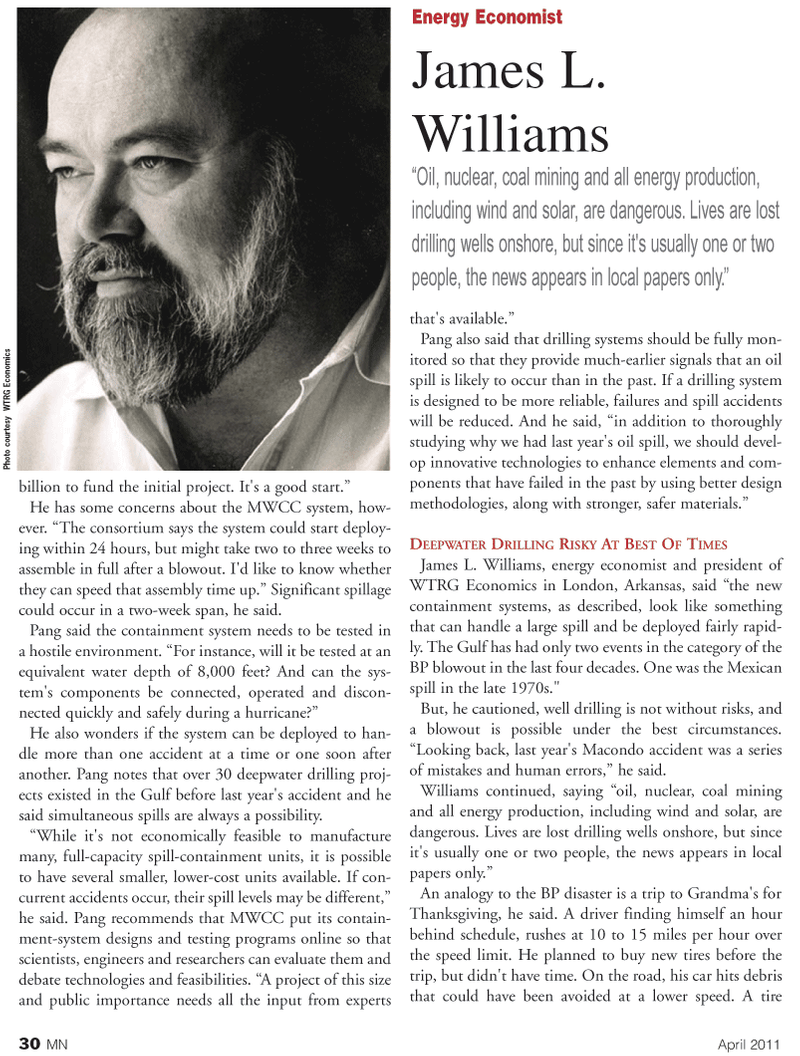
Page 30: of Marine News Magazine (April 2011)
Offshore Energy Edition
Read this page in Pdf, Flash or Html5 edition of April 2011 Marine News Magazine
30 MN April 2011 billion to fund the initial project. It's a good start.”
He has some concerns about the MWCC system, how- ever. “The consortium says the system could start deploy- ing within 24 hours, but might take two to three weeks to assemble in full after a blowout. I'd like to know whether they can speed that assembly time up.” Significant spillage could occur in a two-week span, he said.
Pang said the containment system needs to be tested in a hostile environment. “For instance, will it be tested at an equivalent water depth of 8,000 feet? And can the sys- tem's components be connected, operated and discon- nected quickly and safely during a hurricane?”
He also wonders if the system can be deployed to han- dle more than one accident at a time or one soon after another. Pang notes that over 30 deepwater drilling proj- ects existed in the Gulf before last year's accident and he said simultaneous spills are always a possibility. “While it's not economically feasible to manufacture many, full-capacity spill-containment units, it is possible to have several smaller, lower-cost units available. If con- current accidents occur, their spill levels may be different,” he said. Pang recommends that MWCC put its contain- ment-system designs and testing programs online so that scientists, engineers and researchers can evaluate them and debate technologies and feasibilities. “A project of this size and public importance needs all the input from experts that's available.”
Pang also said that drilling systems should be fully mon- itored so that they provide much-earlier signals that an oil spill is likely to occur than in the past. If a drilling system is designed to be more reliable, failures and spill accidents will be reduced. And he said, “in addition to thoroughly studying why we had last year's oil spill, we should devel- op innovative technologies to enhance elements and com- ponents that have failed in the past by using better design methodologies, along with stronger, safer materials.”
DEEPWATER DRILLING RISKY AT BEST OF TIMES
James L. Williams, energy economist and president of
WTRG Economics in London, Arkansas, said “the new containment systems, as described, look like something that can handle a large spill and be deployed fairly rapid- ly. The Gulf has had only two events in the category of the
BP blowout in the last four decades. One was the Mexican spill in the late 1970s."
But, he cautioned, well drilling is not without risks, and a blowout is possible under the best circumstances. “Looking back, last year's Macondo accident was a series of mistakes and human errors,” he said.
Williams continued, saying “oil, nuclear, coal mining and all energy production, including wind and solar, are dangerous. Lives are lost drilling wells onshore, but since it's usually one or two people, the news appears in local papers only.”
An analogy to the BP disaster is a trip to Grandma's for
Thanksgiving, he said. A driver finding himself an hour behind schedule, rushes at 10 to 15 miles per hour over the speed limit. He planned to buy new tires before the trip, but didn't have time. On the road, his car hits debris that could have been avoided at a lower speed. A tire
Energy Economist
James L.
Williams “Oil, nuclear, coal mining and all energy production, including wind and solar, are dangerous. Lives are lost drilling wells onshore, but since it's usually one or two people, the news appears in local papers only.”
Photo cour tesy WTRG Economics

 29
29

 31
31
